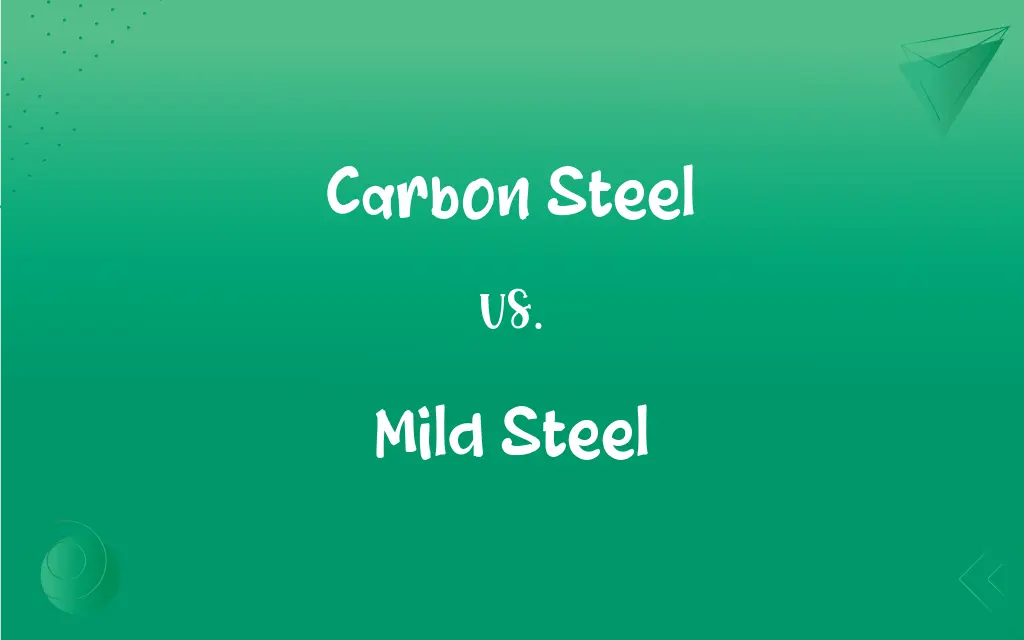Carbon Steel vs. Mild Steel: What's the Difference?
Edited by Aimie Carlson || By Janet White || Published on November 26, 2023
Carbon steel is an alloy with higher carbon content for strength and durability, while mild steel is a low-carbon variant, softer and more malleable.

Key Differences
Carbon steel is an alloy consisting primarily of iron and a higher carbon content, offering greater tensile strength and durability. While, mild steel, a subset of carbon steel, has significantly lower carbon content, making it softer and more pliable.
In carbon steel, the carbon content can range from 0.05% to 2.5%, which affects its strength and brittleness. Mild steel, in contrast, typically contains about 0.05% to 0.25% carbon, which contributes to its ductility and weldability.
Due to its high carbon content, carbon steel is more prone to corrosion and requires protective coatings in certain applications. Mild steel, however, with its lower carbon content, is less susceptible to corrosion but still requires protective measures.
Carbon steel is preferred in applications requiring durability and resistance to wear, such as in tools and machinery parts. Mild steel is commonly used in construction and automotive industries due to its malleability and lower cost.
Carbon steel's higher carbon content also makes it less ductile, affecting its use in applications requiring flexibility. Mild steel's low carbon content provides greater flexibility, making it suitable for bending and forming processes.
ADVERTISEMENT
Comparison Chart
Carbon Content
Higher (0.05% to 2.5%)
Lower (about 0.05% to 0.25%)
Strength and Hardness
Higher strength and hardness due to more carbon.
Softer and more malleable due to less carbon.
Ductility and Weldability
Less ductile, more difficult to weld.
More ductile, easier to weld.
Corrosion Resistance
More prone to corrosion, requires protective coatings.
Less prone to corrosion but still needs protection.
Common Applications
Used in tools, machinery parts, and high-strength components.
Widely used in construction, automotive, and everyday applications.
ADVERTISEMENT
Carbon Steel and Mild Steel Definitions
Carbon Steel
Steel where the primary interstitial alloying constituent is carbon.
Carbon steel pipes are preferred for their strength in industrial settings.
Mild Steel
The most common form of steel, known for its ductility and weldability.
Mild steel bars are frequently used in building construction.
Carbon Steel
Steel with a notable amount of carbon used for structural strength.
Bridges often utilize carbon steel for its load-bearing capabilities.
Mild Steel
A low-carbon variant of steel, suitable for a wide range of applications.
Mild steel sheets are often employed in the creation of metal furniture.
Carbon Steel
An alloy of iron and carbon with a high carbon content.
Carbon steel is extensively used in the manufacturing of cutting tools.
Mild Steel
Steel with a lower carbon content, ideal for bending and forming.
Mild steel pipes are used in plumbing for their easy manipulation.
Carbon Steel
A type of steel characterized by its carbon content influencing its properties.
The gears were made of carbon steel for enhanced durability.
Mild Steel
A type of carbon steel with a low percentage of carbon.
Mild steel is commonly used in automobile body panels due to its malleability.
Carbon Steel
A category of steel with varying levels of carbon, impacting its hardness.
High-carbon steel is chosen for its ability to maintain a sharp edge in knives.
Mild Steel
Steel containing a small proportion of carbon, making it softer and more flexible.
The artist used mild steel for the sculpture to easily mold it into shape.
FAQs
What is the primary difference between carbon steel and mild steel?
The primary difference is the carbon content; carbon steel has higher carbon content compared to mild steel.
Can both carbon steel and mild steel rust?
Yes, both can rust without proper coatings, but carbon steel is more prone to corrosion.
Is carbon steel harder than mild steel?
Yes, carbon steel is generally harder due to its higher carbon content.
Is carbon steel suitable for outdoor structures?
Carbon steel can be used outdoors but requires protective coatings to prevent corrosion.
What industries commonly use mild steel?
Mild steel is commonly used in the construction and automotive industries.
Is welding easier with mild steel compared to carbon steel?
Yes, mild steel is easier to weld due to its lower carbon content.
Are carbon steel and mild steel magnetic?
Yes, both are magnetic due to their iron content.
How is mild steel protected from corrosion?
Mild steel is often coated with paint, zinc, or other protective layers to prevent corrosion.
Does the carbon content affect the weight of the steel?
Yes, higher carbon content can slightly increase the density and weight of the steel.
Which is more expensive, carbon steel or mild steel?
Carbon steel is typically more expensive due to its higher carbon content and strength.
Can mild steel be used for cutting tools?
Mild steel is not typically used for cutting tools as it is softer; carbon steel is preferred for such applications.
Is mild steel environmentally friendly?
Mild steel is recyclable, making it relatively environmentally friendly.
Is carbon steel used in the manufacturing of vehicle parts?
Yes, carbon steel is used in some vehicle parts, especially where strength is required.
What makes mild steel a popular choice in construction?
Its affordability, weldability, and sufficient strength make it popular in construction.
Can carbon steel be recycled?
Yes, carbon steel is recyclable.
Is mild steel suitable for high-strength applications?
Mild steel is not typically used for high-strength applications; carbon steel is more suitable.
How does temperature affect carbon steel and mild steel?
Extreme temperatures can affect the properties of both, but carbon steel generally has a higher tolerance for heat.
Can carbon steel be easily bent and shaped?
Carbon steel is less malleable than mild steel and can be harder to bend and shape.
Are there any health risks associated with machining these steels?
Proper safety measures should be taken to avoid inhalation of fumes or dust during machining of any steel.
Are there different grades of carbon steel?
Yes, there are various grades, each with different carbon content and properties.
About Author
Written by
Janet WhiteJanet White has been an esteemed writer and blogger for Difference Wiki. Holding a Master's degree in Science and Medical Journalism from the prestigious Boston University, she has consistently demonstrated her expertise and passion for her field. When she's not immersed in her work, Janet relishes her time exercising, delving into a good book, and cherishing moments with friends and family.
Edited by
Aimie CarlsonAimie Carlson, holding a master's degree in English literature, is a fervent English language enthusiast. She lends her writing talents to Difference Wiki, a prominent website that specializes in comparisons, offering readers insightful analyses that both captivate and inform.






































































